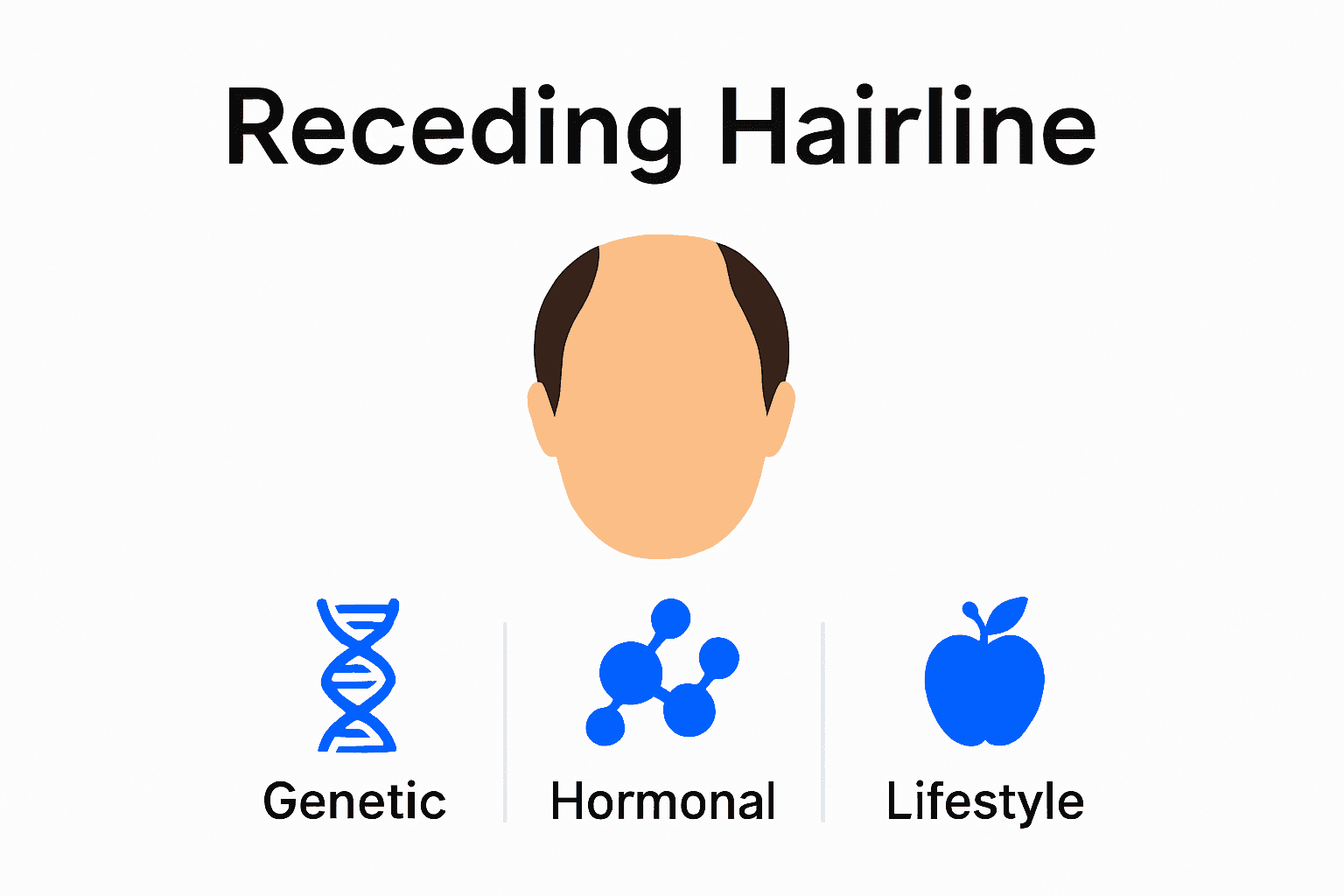Blog
Learning Materials
Best Natural Treatment for Receding Hairline in 2025: Safe & Effective Solutions
Updated: June 12, 2025

Thinning hairlines make most people reach for expensive products or risky procedures. Yet, androgenetic alopecia accounts for up to 80 percent of male pattern baldness and genetics are only one piece of the story. Emerging science flips the script with natural remedies and daily habits that go beyond quick fixes, offering safer results than you might expect in 2025. Here is why these natural approaches get real attention from researchers and those looking for lasting change.
Table of Contents
- Understanding Causes Of A Receding Hairline
- Top Natural Remedies Backed By Science
- Daily Habits For Healthier, Thicker Hair
- Tracking Progress And Personalizing Your Hair Care
Quick Summary
| Takeaway | Explanation |
|---|---|
| Genetic Predisposition is Key | Understanding your genetic risks for hair loss can inform proactive management strategies to mitigate hairline recession. |
| Incorporate Natural Remedies | Utilize herbal extracts like saw palmetto and dietary interventions rich in biotin and zinc, as they are backed by research for improving hair health. |
| Practice Daily Scalp Care | Engage in regular scalp massages and use essential oils to enhance circulation and support hair growth effectively. |
| Adopt Stress Management Techniques | Implement daily stress-reduction methods such as meditation and regular exercise, which can help prevent hair loss. |
| Utilize Advanced Monitoring | Take advantage of AI-powered diagnostic technologies to track hair health and tailor personalized treatment plans for effective results. |
Understanding Causes of a Receding Hairline
A receding hairline represents a complex interplay of biological, genetic, and environmental factors that progressively impact hair growth patterns. Understanding these underlying mechanisms is crucial for developing targeted natural treatment strategies.
Genetic Predisposition: The Primary Driver
Genetic factors play a dominant role in hair loss, with research from the National Institutes of Health revealing that androgenetic alopecia accounts for up to 80% of male pattern baldness. This hereditary condition directly influences hair follicle sensitivity to hormonal changes, causing progressive miniaturization and eventual hair loss.
The genetic component determines how susceptible your hair follicles are to dihydrotestosterone (DHT), a hormone that triggers hair follicle shrinkage. Individuals with a family history of hair loss are significantly more likely to experience a receding hairline earlier in life. While genetics cannot be altered, understanding your genetic predisposition can help you develop proactive management strategies.
Hormonal Influences on Hair Growth
Hormonal imbalances represent another critical factor in hairline recession. According to endocrinology research, elevated DHT levels can dramatically impact hair follicle health. These hormonal shifts not only affect men but also significantly impact women, particularly during hormonal transitions like menopause or conditions such as polycystic ovary syndrome (PCOS).
Thyroid disorders can further complicate hair growth dynamics. Hypothyroidism and hyperthyroidism both disrupt the delicate hormonal balance necessary for consistent hair production. When thyroid function is compromised, hair follicles may enter prolonged resting phases, leading to increased hair thinning and potential recession.
Environmental and Lifestyle Factors
Beyond genetic and hormonal influences, lifestyle choices dramatically impact hair health. Chronic stress emerges as a significant contributor to hair loss, triggering a condition called telogen effluvium where hair prematurely enters the resting phase. Nutritional deficiencies particularly in proteins, iron, and vitamins B12 and D can further accelerate hair follicle deterioration.
Additionally, certain hair care practices and environmental exposures can exacerbate hairline recession. Frequent use of harsh chemical treatments, excessive heat styling, tight hairstyles causing traction, and prolonged exposure to environmental pollutants can weaken hair structure and impede healthy growth. Poor scalp circulation, often resulting from sedentary lifestyles or inadequate nutrition, can also compromise hair follicle vitality.
By comprehensively understanding these multifaceted causes, individuals can develop more targeted and effective approaches to managing and potentially reversing hairline recession through natural interventions.

Top Natural Remedies Backed by Science
Natural approaches to addressing receding hairlines offer promising alternatives to invasive treatments, focusing on holistic strategies that support hair health from within. Scientific research increasingly validates specific natural interventions that can potentially slow hair loss and promote healthier hair growth.
Herbal Extracts and Botanical Solutions
Research published in the Journal of Cosmetic Dermatology highlights saw palmetto as a powerful natural remedy for hair loss. This botanical extract works by blocking 5-alpha reductase, an enzyme that converts testosterone to dihydrotestosterone (DHT), a hormone responsible for hair follicle miniaturization. A 2022 systematic review demonstrated that saw palmetto can significantly improve hair count and thickness in clinical trials.
Other potent botanical solutions include:
- Ginseng: Stimulates hair follicle cells and improves blood circulation
- Pumpkin Seed Oil: Contains phytosterols that may block DHT production
- Green Tea Extract: Rich in antioxidants that support scalp health
Nutritional Interventions for Hair Restoration
Dietary approaches play a crucial role in supporting natural hair growth. Nutritional research from Harvard Medical School emphasizes the importance of specific nutrients in maintaining hair health. Antioxidant-rich foods like blueberries, spinach, kidney beans, and walnuts combat oxidative stress that contributes to hair aging and loss.
Key nutrients essential for hair health include:
- Biotin: Supports keratin production
- Zinc: Crucial for hair tissue growth and repair
- Vitamin D: Helps create new hair follicles
- Iron: Prevents hair loss associated with deficiency
Topical Natural Treatments and Scalp Care

Topical treatments offer a direct approach to supporting hair growth. Clinical studies published in the International Journal of Trichology demonstrate the effectiveness of natural topical solutions. Essential oils like rosemary and peppermint have shown promising results in improving hair growth and scalp health.
Effective natural topical treatments include:
- Rosemary Oil: Comparable to minoxidil in promoting hair growth
- Aloe Vera: Soothes scalp and reduces inflammation
- Coconut Oil: Penetrates hair shaft to prevent protein loss
It is important to note that while these natural remedies show scientific promise, individual results can vary. Consistency is key, and individuals should approach hair loss treatment as a comprehensive strategy combining multiple approaches. Consulting with a healthcare professional can help develop a personalized treatment plan that addresses the unique underlying causes of hair loss.
By integrating these scientifically-backed natural remedies, individuals can take a proactive approach to managing receding hairlines and supporting overall hair health.
Daily Habits for Healthier, Thicker Hair
Transforming your hair health requires consistent daily practices that support follicle strength, scalp nutrition, and overall hair growth. By implementing strategic habits, you can create an environment that promotes healthier, more resilient hair and potentially mitigate the progression of a receding hairline.
Nutrition and Hydration Strategies
Research published in the International Journal of Trichology emphasizes the critical role of daily nutrition in hair health. Consuming a balanced diet rich in protein, vitamins, and minerals directly impacts hair growth and strength. A study tracking individuals with daily curry leaf extract consumption revealed a remarkable 30% increase in hair thickness over six months, highlighting the power of targeted nutritional interventions.
Key daily nutritional habits include:
- Protein Intake: Consuming lean proteins like fish, eggs, and legumes
- Hydration: Drinking at least 8 glasses of water daily
- Micronutrient-Rich Foods: Incorporating spinach, berries, and nuts
Scalp Care and Circulation Techniques
Clinical research from dermatological experts demonstrates that daily scalp massage and proper care can significantly improve hair growth. Gentle massage techniques stimulate blood circulation, delivering essential nutrients to hair follicles and potentially slowing hair recession. Research indicates that consistent scalp care can reduce inflammation and support healthier hair growth.
Effective daily scalp care practices include:
- Scalp Massage: 5-10 minutes of gentle circular motions
- Essential Oil Application: Using rosemary or peppermint oils
- Gentle Cleansing: Using sulfate-free, scalp-friendly shampoos
Stress Management and Lifestyle Optimization
Chronic stress represents a significant contributor to hair loss, disrupting natural hair growth cycles. Endocrinology studies reveal that daily stress management techniques can dramatically improve hair health. Early clinical trials of a holistic approach showed up to a 26% increase in new hair growth within three months when participants integrated stress reduction and natural supplementation.
Recommended daily stress management techniques:
- Meditation: 10-15 minutes of daily mindfulness practice
- Regular Exercise: 30 minutes of moderate physical activity
- Sleep Hygiene: Maintaining a consistent 7-9 hour sleep schedule
Importantly, these habits work synergistically. No single approach guarantees complete hair restoration, but a comprehensive daily routine can significantly support hair health. Consistency is key. Individuals should approach hair care as a long-term commitment, understanding that results develop gradually.
By integrating these scientifically-supported daily habits, you create an optimal environment for hair growth, potentially slowing the progression of a receding hairline and promoting overall scalp health.
Tracking Progress and Personalizing Your Hair Care
In the era of personalized healthcare, managing a receding hairline requires a sophisticated approach that combines advanced technology, systematic tracking, and individualized strategies. Modern hair care solutions now offer unprecedented insights into hair health, empowering individuals to take proactive and precise actions.
Advanced Diagnostic Technologies
AI-powered diagnostic platforms have revolutionized hair health monitoring in 2025. These sophisticated tools can analyze hair density, follicle health, and growth patterns with remarkable precision. By utilizing high-resolution imaging and machine learning algorithms, these technologies provide detailed visualizations of hair thickness, scalp condition, and potential recession progression.
Key technological tracking features include:
- Digital Follicle Mapping: Creating comprehensive visual records of hair growth
- Scalp Microbiome Analysis: Identifying potential underlying health factors
- Growth Rate Calculation: Measuring monthly hair regeneration
Personalized Treatment Stratification
Precision medicine research emphasizes the importance of individualized approaches in hair loss management. By combining genetic profiling, hormonal assessments, and lifestyle evaluations, healthcare professionals can develop targeted interventions that address specific underlying causes of hair recession.
Comprehensive personalization strategies involve:
- Genetic Risk Assessment: Understanding inherited hair loss predispositions
- Hormonal Profile Evaluation: Identifying potential endocrine disruptions
- Lifestyle Impact Analysis: Determining individual stress and nutritional influences
Continuous Monitoring and Adaptive Strategies
Clinical studies demonstrate that consistent tracking enables more effective interventions. Modern approaches recommend quarterly assessments to evaluate treatment effectiveness and make necessary adjustments. Digital platforms now allow seamless documentation of progress, enabling individuals to visualize improvements and maintain motivation.
Effective monitoring techniques include:
- Quarterly Photographic Documentation: Creating standardized comparison images
- Digital Progress Journals: Tracking treatment responses
- Automated Recommendation Systems: Suggesting personalized interventions based on ongoing data
Successful hair care management in 2025 transcends traditional treatments. It represents a holistic, data-driven journey that combines medical insights, technological innovation, and personalized strategies. By embracing these advanced tracking methodologies, individuals can develop comprehensive, adaptive approaches to managing hair health.
Remember that while technology provides powerful tools, professional consultation remains crucial. Dermatologists and trichologists can interpret complex data and provide nuanced guidance tailored to individual physiological characteristics.
Frequently Asked Questions
What are the best natural treatments for a receding hairline?
Natural treatments include herbal extracts like saw palmetto, topical solutions such as rosemary oil, and dietary interventions rich in biotin, zinc, and vitamins. These remedies are scientifically supported and focus on promoting hair health.
How does diet affect hair health and a receding hairline?
Diet plays a crucial role in hair health. Consuming nutrient-dense foods, particularly those rich in protein, iron, and vitamins like biotin and Vitamin D, supports hair growth and may help mitigate a receding hairline.
Can stress management prevent hair loss associated with a receding hairline?
Yes, managing stress is essential for preventing hair loss. Techniques such as meditation, regular exercise, and maintaining good sleep hygiene can help alleviate stress and promote healthier hair growth by reducing the impact of stress-induced hair loss.
How can I track progress when using natural remedies for hair loss?
Utilizing AI-powered diagnostic technologies can help you track hair density, follicle health, and growth patterns. Regular assessments, photographic documentation, and digital progress journals keep you informed about the effectiveness of your treatment plan.
Ready To See Real Progress With Your Hairline?
If you are tired of trying endless natural remedies and guessing what truly works for your receding hairline, you are not alone. This article has highlighted how genetics, hormones, daily habits, and nutrition all play unique roles in hair thinning. But knowing the right strategies is just the beginning. What you really want is visible change and confidence that your choices match your unique hair needs. The frustration of stalled results or unclear progress stops here.

Get personalized answers and track your improvement using MyHair.ai. Upload your own hair scans to receive instant, AI-powered analysis and custom recommendations tailored to your biology and goals. See your hair growth data over time, adjust your natural routine based on science, and stop operating in the dark. Join others who chose tech-backed support and take your first confident step with MyHair.ai today.